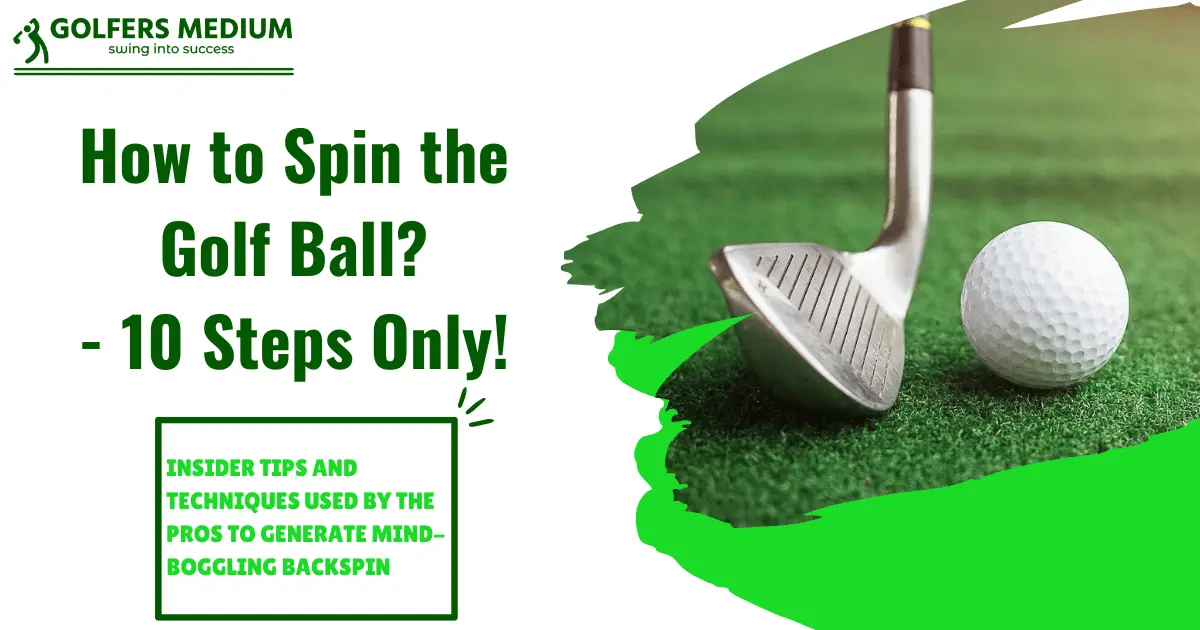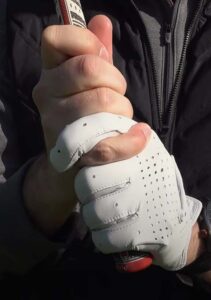To spin a golf ball, also known as creating backspin, you need to understand the technique and practice it consistently.
In this article, we will reveal the insider tips and techniques used by the pros to generate mind-boggling backspin. From selecting the perfect equipment, nailing the grip and ball position, to mastering the art of the descending strike and wrist action, we’ll guide you through each step with precision.
Here is a step-by-step guide on how to spin a golf ball:
Step 1 – Use the Right Equipment

- Choose a high-quality golf ball designed for spin control. Look for balls with a urethane cover as they tend to generate more spin.
- Consider using wedges or short irons with higher lofts, as they are more suitable for generating spin.
Step 2 – Adjust Your Grip
- Grip the club firmly but not too tightly. An excessively tight grip restricts wrist movement, reducing your ability to generate spin. Read my another article If you want to know more about proper golf grip.
Step 3 – Position the Ball Correctly
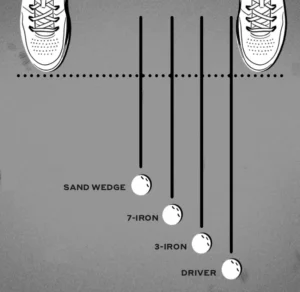
- Place the ball slightly forward in your stance, closer to your left foot (for right-handed golfers). This positioning promotes a steeper angle of attack, aiding in spin creation.
Step 4 – Angle of Attack
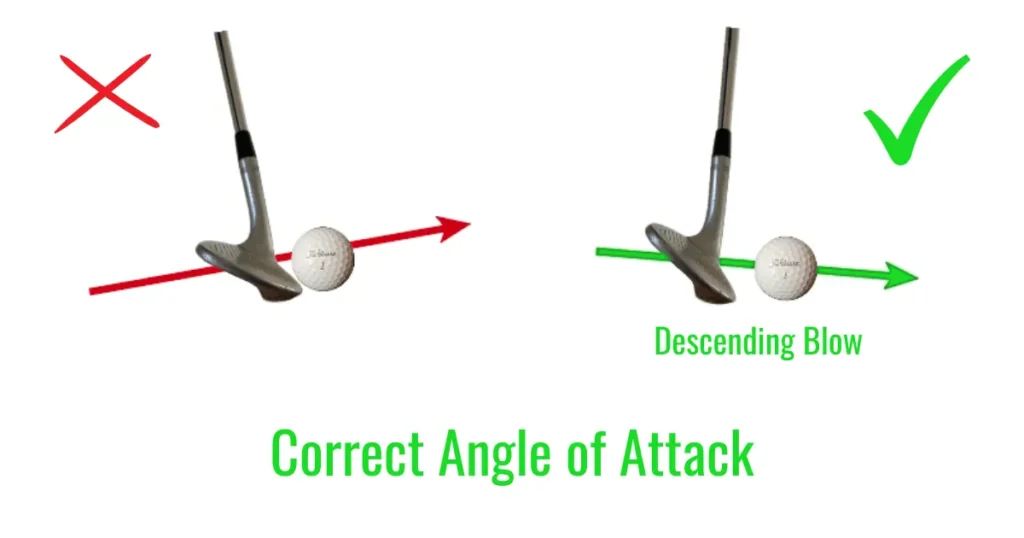
- Aim to strike the ball with a slightly descending blow. This means that the clubhead should be moving slightly downward at the moment of impact. This technique helps create backspin.
Step 5 – Generate Adequate Swing Speed
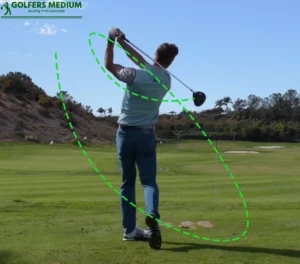
- Swing the club with sufficient speed to generate spin. However, remember to maintain control and tempo throughout your swing.
Step 6 – Utilize Proper Wrist Action
- Keep your wrists firm during the backswing, but allow them to unhinge and release as you approach impact. This action adds snap to the clubhead, increasing spin production.
Step 7 – Aim for Clean Contact
- Strive for clean contact between the clubface and the ball. Hitting the ball with the club’s grooves helps grip the ball and generate spin.
- Avoid hitting the ground before the ball, as it reduces spin and may result in poor contact.
Step 8 – Follow Through Completely
- Let your hands lead the clubhead through impact and continue with a full follow-through. This motion ensures proper contact and maximizes spin potential.
Step 9 – Practice Consistently
- Developing the ability to spin a golf ball takes practice and repetition. Allocate time for focused practice sessions specifically dedicated to improving your spin control.
Step 10 – Experiment and Adjust
- Experiment with different clubs, swing speeds, and wrist actions to find the combination that generates the desired spin.
- Pay attention to the results and make adjustments to your technique as necessary.
What drills or exercises can enhance my ability to spin the golf ball?
There are several drills and exercises you can incorporate into your practice routine to improve your ability to spin the golf ball.
- One effective drill is to practice hitting pitch shots with different clubs, focusing on generating maximum backspin. Experiment with varying swing speeds, clubface angles, and wrist actions to observe the impact on spin.
- Another helpful exercise is to place an alignment stick or towel a few inches behind the ball and practice hitting shots without touching the stick or towel. This drill promotes clean contact and encourages a downward strike, crucial for generating spin.
- Additionally, you can work on your wrist action by performing wrist hinge and release exercises, ensuring proper timing and snap through impact.
- Finally, incorporating short game practice, such as bunker shots and chip shots, will allow you to develop precise control over spin in different situations. Remember, consistent practice and deliberate focus on spin-related drills and exercises will contribute to enhancing your ability to spin the golf ball like a pro.
Common mistakes or misconceptions to watch out!
There are some common mistakes or misconceptions when you are spinning the golf ball that you should avoid. Here are some of them:
- Overswinging: Trying to generate excessive speed or power can lead to loss of control and negatively affect spin. Focus on a controlled and balanced swing instead.
- Improper ball position: Placing the ball too far back in your stance can result in a shallow angle of attack, reducing spin. Ensure the ball is positioned slightly forward for a steeper strike.
- Gripping too tightly: Holding the club too tightly restricts wrist action, making it challenging to generate the necessary snap for backspin. Maintain a firm but relaxed grip. More info about gripping here.
- Neglecting clean contact: Hitting the ground before the ball or striking the ball with the wrong part of the clubface can reduce spin. Aim for clean contact at the center or slightly above the club’s sweet spot.
- Lack of wrist release: Failing to properly release the wrists at impact diminishes the potential for generating spin. Practice releasing the wrists through impact for optimal spin production.
- Not adjusting for course conditions: Different course conditions, such as firm or soft turf, can influence spin. Adapt your technique accordingly by adjusting the angle of attack and club selection.
- Neglecting short game practice: Spin control is crucial in the short game. Practice a variety of shots around the green, including bunker shots and chip shots, to improve your ability to generate spin in different scenarios.
Are there any advanced techniques or tricks that experienced golfers use to enhance their spin control?
There are several advanced technique used by experienced golfers. Here are some of them:
- Opening or closing the clubface: By slightly opening or closing the clubface at address, experienced golfers can influence the spin axis of the ball. This technique can be used to add side spin for specific shot shapes or to manipulate the amount of backspin.
- Varying ball position: Advanced golfers experiment with different ball positions to adjust the angle of attack and spin characteristics. Moving the ball slightly back in the stance can promote a lower, more controlled trajectory with increased spin.
- Deliberate spin loft control: Spin loft refers to the difference between the angle of attack and the dynamic loft at impact. Skilled golfers manipulate the spin loft by adjusting their swing plane, club selection, and setup to optimize spin production.
- Utilizing ball compression: Advanced golfers take advantage of their ability to control ball compression to generate spin. By compressing the ball properly at impact, they maximize the interaction between the clubface and the ball, resulting in increased spin.
- Experimenting with specialized shots: Skilled golfers develop a repertoire of specialty shots, such as flop shots, check shots, and low-spin shots. These shots require precise control of spin and are used strategically in different on-course situations.
How long does it typically take to develop the skill of spinning the golf ball consistently?
The time it takes to develop the skill of spinning the golf ball consistently can vary depending on several factors, including your current skill level, practice frequency, and dedication to improving. Generally, it can take several months to years of focused practice to develop a high level of spin control.
Final Thoughts
I hope this article was helpful. With practice and dedication, you’ll gradually develop the skills needed to spin the golf ball with confidence and finesse. So, step onto the course with determination, armed with newfound knowledge, and watch as your ability to control spin transforms your game.
Hi! I am Hannah, a golf enthusiast, have been perfecting my swing for over a decade, making long putts a breeze. Aside from playing, I am a professional golf writer, I try capture the nuances of the game and inspire others to embrace their love for golf. Follow me on Twitter.

